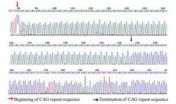(Press-News.org) People can only recognize two faces in a crowd at a time – even if the faces belong to famous people. So says Volker Thoma of the University of East London in the UK in an article which sheds light on people's ability to process faces, published in Springer's journal Psychonomic Bulletin & Review. The findings have relevance to giving eye-witness testimony or for neuropsychological rehabilitation.
Thoma set up two experiments in which participants were asked to identify a famous politician such as Tony Blair and Bill Clinton or pop stars such as Mick Jagger and Robbie Williams from among other unfamiliar faces. In both cases, a distractor face was placed to the side of the screen, but participants were asked to ignore it.
In the first experiment, the famous face was shown at the vertical center of the computer screen, either on its own or among one or two unknown faces. Participants had to quickly respond to whether it was a famous politician or singer. Despite being asked to ignore the unknown face on the periphery, its presence still influenced participants' ability to recognize the famous face, showing that faces are hard to ignore. However, when more faces were shown in the center – making it harder to find Mick Jagger – participants did not notice the irrelevant face anymore. According to Thoma, this indicates that humans can only deal with and process a few faces at a time, whether they are well known or not.
Interestingly, the same thing also happened in the second experiment when the additional faces surrounding the famous person's photograph were shown upside down. Thoma describes this result as "surprising," as upside-down faces are usually less recognizable and easier to ignore. In fact, it was previously thought that upside down faces are not perceived as individual faces, but more like objects. One would have therefore expected the famous face to stand out, which it didn't.
So far it has been assumed that humans recognize faces as one whole object or image, and not by looking at different parts (such as lips, ears and eyes) or local features that together form a face. Thoma now says that face parts rather than whole faces interfere with our limited capacity to identify faces.
"People recognize faces automatically as long as they have sufficient capacity to do so, but not when this ability is stretched by the presence of too many faces," explains Thoma further. "Face recognition seems to be limited to the amount of face-specific resources or parts, and even happens when other faces are shown upside down."
INFORMATION:
Reference: Thoma, V. (2014). Face-specific Capacity Limits under Perceptual Load Do not Depend on Holistic Processing, Psychonomic Bulletin & Review DOI 10.3758/s13423-014-0633-2
The full-text article is available to journalists on request.
Spotting a famous face in the crowd
Using faces of Bill Clinton and Mick Jagger, researcher shows what mechanisms interfere with our ability to recognize faces
2014-05-05
ELSE PRESS RELEASES FROM THIS DATE:
Virtual patients, medical records and sleep queries may help reduce suicide
2014-05-05
AUGUSTA, Ga. - A virtual patient, the electronic medical record, and questions about how well patients sleep appear effective new tools in recognizing suicide risk, researchers say.
A fourth – and perhaps more powerful – tool against suicide is the comfort level of caregivers and family members in talking openly about it, said Dr. W. Vaughn McCall, Chairman of the Department of Psychiatry and Health Behavior at the Medical College of Georgia at Georgia Regents University.
Suicide is among the top 10 causes of death in the United States for every group age 10 and older, ...
Light-sensitive 'eyes' in plants
2014-05-05
Most plants try to turn towards the sun. Scientists from the University of Gothenburg have worked with Finnish colleagues to understand how light-sensitive proteins in plant cells change when they discover light. The results have been published in the most recent issue of Nature.
The family of proteins involved is known as the "phytochrome" family, and these proteins are found in all plant leaves. These proteins detect the presence of light and inform the cell whether it is day or night, or whether the plant is in the shade or the sun.
"You can think of them as the ...
Study reveals potentially unnecessary radiation after suspected sports-related injury
2014-05-05
VANCOUVER, BRITISH COLUMBIA – A new study of Utah youth with suspected sports-related head injuries found that emergency room visits for children with sports-related head injuries have increased since the state's concussion law passed in 2011, along with a rise in head CT scans -- leading to potentially unnecessary radiation exposure.
The results were announced at the Pediatric Academic Societies conference in Vancouver, British Columbia in May by William McDonnell, M.D., J.D., associate professor of pediatrics at the University of Utah.
The study, completed by McDonnell ...
New research explores how smoking while pregnant leads to other diseases
2014-05-05
VANCOUVER, BRITISH COLUMBIA – While many parents-to-be are aware that the health of their baby starts before they've actually arrived into the world, recent research reveals that "harm" (i.e., tobacco smoke, dirty air, poor nutrition, even preeclampsia) may not present itself disease-wise until well into adulthood or when a second harmful "hit" triggers the individual's susceptibility.
The results were announced at the Pediatric Academic Societies conference in Vancouver, British Columbia in May by Lisa Joss-Moore, Ph.D., University of Utah Department of Pediatrics. ...
Uncorking East Antarctica yields unstoppable sea-level rise
2014-05-05
The melting of a rather small ice volume on East Antarctica's shore could trigger a persistent ice discharge into the ocean, resulting in unstoppable sea-level rise for thousands of years to come. This is shown in a study now published in Nature Climate Change by scientists from the Potsdam Institute for Climate Impact Research (PIK). The findings are based on computer simulations of the Antarctic ice flow using improved data of the ground profile underneath the ice sheet.
"East Antarctica's Wilkes Basin is like a bottle on a slant," says lead-author Matthias Mengel, ...
Dual method to remove precancerous colon polyps may substantially reduce health-care costs
2014-05-05
Chicago, IL (May 5, 2014) — A surgical method combining two techniques for removing precancerous polyps during colonoscopies can substantially reduce the recovery time and the length of hospital stays, potentially saving the health-care system millions of dollars, according to research presented today at Digestive Disease Week® (DDW).
"Not only did we find that patients were discharged a day and a half earlier, we discovered other benefits, which could transform our approach to removing difficult colon polyps," said Jonathan Buscaglia, MD, the study's lead researcher ...
Women and PAD: Excellent treatment outcomes in spite of disease severity
2014-05-05
ANN ARBOR, Mich. – Women face greater limits on their lifestyle and have more severe symptoms as a result of peripheral artery disease (PAD), but minimally invasive procedures used to unclog arteries are just as successful as in men.
The success of procedures, such as angioplasty or stent placement, in treating women with leg PAD was revealed in a Journal of the American College of Cardiology study.
The study provides a rare look at gender differences in PAD. PAD happens when fatty deposits build up in arteries outside the heart, usually the arteries supplying fresh ...
Cajal-Retzius cell loss and amyloidosis in Alzheimer's disease
2014-05-05
Cajal-Retzius cells are reelin-secreting neurons in the marginal zone of the neocortex and hippocampus. However, the relationship between Cajal-Retzius cells and Alzheimer's disease is unknown. Dr. Jinbo Deng and team from Henan University in China revealed that the number of Cajal-Retzius cells markedly reduced with age in both wild type and in mice over-expressing the Swedish double mutant form of amyloid precursor protein 695 (transgenic (Tg) 2576 mice). The decline in Cajal-Retzius cells in Tg2576 mice was found to occur concomitantly with the onset of Alzheimer's disease ...
New knowledge about muscular dystrophy
2014-05-05
The most common form of muscular dystrophy among adults is dystrophia myotonica type 1 (DM1), where approximately 1 in every 8000 is affected by the disease. The severity of the disease varies from mild forms to severe congenital forms. It is dominantly inherited and accumulates through generations, gaining increased severity and lowered age of onset. DM1 is characterised by accumulating toxic aggregates of ribonucleic acids (RNA) from a specific mutated gene (see figure 1).
When this RNA, which contains thousands of CUG nucleotide repeats, builds up in the cell, it attracts ...
Genetic diagnosis can rule out a suspected Huntington's chorea patient
2014-05-05
Huntington's disease is an autosomal-dominant inherited neurodegenerative disease with a distinct phenotype, but the pathogenesis is unclear. Although patients with a family history have more typical clinical symptoms, signs, and pathological changes, as well as an unambiguous clinical diagnosis, other diseases with dance-like movements, e.g., dentatorubral-pallidoluy-sian atrophy, spinocerebellar ataxia type 17, Huntington's disease-like-2, and neuroferritinopathy, are difficult to identify and distinguish from Huntington's disease. By mutation screening for CAG repeats ...
LAST 30 PRESS RELEASES:
Insilico Medicine and Taigen achieves license agreement to develop and commercialize AI-driven PHD inhibitor for anemia of Chronic Kidney Disease (CKD)
Exploring dominant endophytic Pleosporales in grasses: New taxonomic insights in the suborder Massarineae
Comparative transcriptomic analysis of human maxillary and mandibular tooth germs reveals discrepancies in gene expression patterns
Scientists detect atmosphere on molten rocky exoplanet - study
Chip-scale magnetometer uses light for high-precision magnetic sensing
Illinois Tech biomedical engineering professor Philip R. Troyk elected as Fellow of the National Academy of Inventors
The National Academy of Inventors welcomes 2025 Class of Fellows
Multi-scale modelling framework predicts mechanical responses of Fe–Cr–Al alloys across composition and processing conditions
Preoperative radiation may improve antitumor immune response in most common form of breast cancer
Breast MRI may be safely omitted from diagnostic workup in certain patients with early-stage, HR-negative breast cancer
Sentinel lymph node biopsy may be safely omitted in some patients with early-stage breast cancer
Rats may seek cannabis to cope with stress
New FAU research strengthens evidence linking alcohol use to cancer
Gut health à la CAR T
Dr. Pengfei Liu receives 2026 O'Donnell Award in Medicine for pioneering advances in genetic diagnostics and rare disease treatment
Dr. Yunsun Nam receives 2026 O'Donnell Award in Biological Sciences for pioneering RNA research transforming gene regulation and cancer therapy
Dr. Bilal Akin wins 2026 O'Donnell Award in Engineering for transformative work in EV energy systems and industrial automation
Dr. Fan Zhang receives 2026 O'Donnell Award in Physical Sciences for groundbreaking discoveries in quantum matter and topological physics
Dr. Yue Hu receives 2026 O'Donnell Award for revolutionizing energy operations with real-time AI and reinforcement learning
Greater risk that the political right falls for conspiracy theories
JMC Publication: Insilico’s AI platforms enable discovery of potent, selective, oral DGKα inhibitor to overcome checkpoint resistance
Targeting collagen signaling boosts drug delivery in pancreatic cancer
Valvular heart disease is common in cancer patients but interventions improve survival
When socially responsible investing backfires
Cuffless blood pressure technologies in wearable devices show promise to transform care
AI-based tool predicts future cardiovascular events in patients with angina
Researchers map how the cerebellum builds its connections with the rest of the brain during early development
Routine scans could detect early prostate radiotherapy changes
Fairness in AI: Study shows central role of human decision-making
Pandemic ‘beneath the surface’ has been quietly wiping out sea urchins around the world
[Press-News.org] Spotting a famous face in the crowdUsing faces of Bill Clinton and Mick Jagger, researcher shows what mechanisms interfere with our ability to recognize faces




